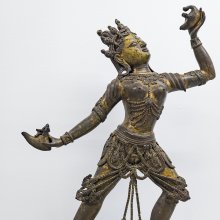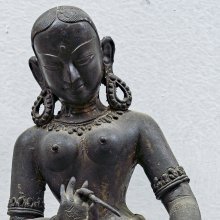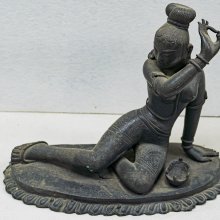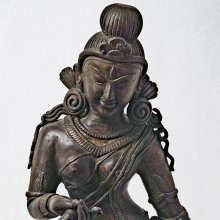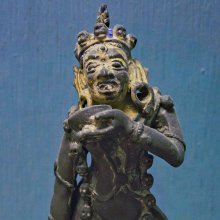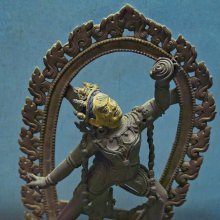Yogini, Yoginī: 15 definitions
Introduction:
Yogini means something in Hinduism, Sanskrit, Jainism, Prakrit, Marathi. If you want to know the exact meaning, history, etymology or English translation of this term then check out the descriptions on this page. Add your comment or reference to a book if you want to contribute to this summary article.
Images (photo gallery)
(+1 more images available)
In Hinduism
Purana and Itihasa (epic history)
Source: archive.org: Shiva Purana - English TranslationYoginī (योगिनी) refers to a group of deities who together with the nine Durgās participated in Vīrabhadra’s campaign against Dakṣa, according to the Śivapurāṇa 2.2.33. Accordingly, as Brahmā narrated to Nārada:—“Mahākālī went ahead for the destruction of Dakṣa accompanied by nine Durgās [...]. The host of Yoginīs with their sixty-four groups set out angrily and hurriedly to destroy Dakṣa’s sacrifice”.
Source: Cologne Digital Sanskrit Dictionaries: The Purana Index1a) Yoginī (योगिनी).—A Varṇa śakti: an attendant on Śiva.*
- * Brahmāṇḍa-purāṇa IV. 44. 59 and 105; III. 41. 30.
1b) The goddess who stands in Kanakhalatīrtha and dances with Śiva.*
- * Matsya-purāṇa 193. 70.

The Purana (पुराण, purāṇas) refers to Sanskrit literature preserving ancient India’s vast cultural history, including historical legends, religious ceremonies, various arts and sciences. The eighteen mahapuranas total over 400,000 shlokas (metrical couplets) and date to at least several centuries BCE.
Shaktism (Shakta philosophy)
Source: academia.edu: Women in Early Śākta TantrasYoginī (योगिनी).—Women endowed with supernatural powers (yoginī).—Human yoginīs form a subtype of the general category of yoginī. Yoginīs or female spirits possessing superhuman powers are said to be divine or human (Siddhayogeśvarīmata 22.5), but, as I argued elsewhere, one could in fact distinguish between three subcategories of yoginīs:
- Divine yoginīs who are identified with mantra syllables;
- Witch-like semi-divine yoginīs who are invoked and appear flying in the cremation ground;
- Human yoginīs who are said to belong to lineages or clans.
The basic typology lists seven types of human yoginīs, who must be recognized and identified through particular features. The seven types, called lineages or clans (kula), are based on the names and traits of the seven mother goddesses:
- Brāhmī,
- Māheśvarī,
- Kaumārī,
- Vaiṣṇavī,
- Vārāhī,
- Aindrī,
- Cāmuṇḍā (or Mātṛnāyikā),
After identifying a yoginī as belonging to one of these seven clans, she must be shown certain hand gestures that represent the divine attributes of her male counterpart (such as the disc, cakra, for Vaiṣṇavī), to which she will react in her particular way. On certain days of the lunar month, her attributes must be drawn on her/the practitioner’s house (there is some ambiguity on this point) and she must be worshipped on these days. These human yoginīs are then said to bestow the ability to fly and other supernatural powers, just as other yoginīs or goddesses do, as well as to transmit the traditional teaching, sampradāya.
All seven types are described in Brahmayāmala 74.41–80 as well as in a long chapter on various yoginīs in the somewhat later Tantrasadbhāva (16.247–285). The Siddhayogeśvarīmata (29.21–51) includes only the first five types. The same yoginī types appear in later texts too, such as in the Jayadrathayāmala (3.38.35ff).

Shakta (शाक्त, śākta) or Shaktism (śāktism) represents a tradition of Hinduism where the Goddess (Devi) is revered and worshipped. Shakta literature includes a range of scriptures, including various Agamas and Tantras, although its roots may be traced back to the Vedas.
Vaishnavism (Vaishava dharma)
Source: Devotees Vaishnavas: Śrī Garga SaṃhitāYoginī (योगिनी) refers to the fifteenth of twenty-six ekādaśīs according to the Garga-saṃhitā 4.8.9. Accordingly, “to attain Lord Kṛṣṇa’s mercy you should follow the vow of fasting on ekādaśī. In that way You will make Lord Kṛṣṇa into your submissive servant. Of this there is no doubt”. A person who chants the names of these twenty-six ekādaśīs (e.g., Yoginī) attains the result of following ekādaśī for one year.

Vaishnava (वैष्णव, vaiṣṇava) or vaishnavism (vaiṣṇavism) represents a tradition of Hinduism worshipping Vishnu as the supreme Lord. Similar to the Shaktism and Shaivism traditions, Vaishnavism also developed as an individual movement, famous for its exposition of the dashavatara (‘ten avatars of Vishnu’).
Shaivism (Shaiva philosophy)
Source: archive.org: Indian Historical Quarterly Vol. 7 (shaivism)Yoginī (योगिनी) refers to one of the twenty-four names of the Lāmās, according to the 8th-centry Jayadratha-yāmala.—While describing the special practices of the Lāmās mentions the special language to be used with them. This language is described as monosyllabic (ekākṣara-samullāpa) and may thus be considered to have belonged to the Sino-Tibetan family as the Lamas themselves belonged to the Tibetan group of mystics. The Lāmās [viz., Yoginī], according to this language, had 24 different names.
Source: Brill: Śaivism and the Tantric Traditions1) Yoginī (योगिनी) refers to a series of six deities part of the Pantheon of mantra-deities, according to verse 4.497ff of the Brahmayāmala-tantra (or Picumata), an early 7th century Śaiva text consisting of twelve-thousand verses.—Accordingly, “[...] Next is installed a second series of seven lotuses, the garland of Yoginīs. In contrast to the first lotus garland, these do not lie in a vertical axis. Three form a kind of girdle: one lotus is placed in the center of the waist, on the back, while the other two lie on either side of the waist. The remaining four lotuses are situated on the sides of the knees and feet. Installed upon these lotuses are goddesses known as the Six Yoginīs, led by a male deity, Ādivīra (“Primordial Hero”), positioned in the lotus on the back of the waist. [...]”.
The six Yoginīs are:
- Kroṣṭukī (oṃ hūṃ caṇḍe kāpālini namaḥ),
- Vijayā (oṃ hūṃ caṇḍe kāpālini svāhā),
- Gajakarṇā (oṃ hūṃ caṇḍe kāpālini hūṃ),
- Mahāmukhī (oṃ hūṃ caṇḍe kāpālini vauṣaṭ),
- Cakravegā (oṃ hūṃ caṇḍe kāpālini vaṣaṭ),
- Mahānāsā (oṃ hūṃ caṇḍe kāpālini phaṭ).
2) Yoginī (योगिनी) refers to a “yoginī-natured woman”, according to the 13th-century Matsyendrasaṃhitā: a Kubjikā-Tripurā oriented Tantric Yoga text of the Ṣaḍanvayaśāmbhava tradition from South India.—Accordingly, “[Devī spoke]:—O God, what kind of a woman is a Yoginī? Who is Māyā and who is Pāśavī? Tell me, O Bhairava, the pros and cons of having sex with them. [Bhairava spoke]:—A woman who is on the Kula Path [of the Yoginī clans], who avoids the path of bound souls [i.e. the path of the uninitiated], who is elevated by intoxication induced by liquor, and is free of the bonds that fetter the soul, and whose mind is filled with the bliss of wine, is [called] a Yoginī in Śiva’s teaching”.
Source: SOAS University of London: Protective Rites in the Netra TantraYoginī (योगिनी) refers to a “group of supernatural beings” that cause illness, according to the Netratantra of Kṣemarāja: a Śaiva text from the 9th century in which Śiva (Bhairava) teaches Pārvatī topics such as metaphysics, cosmology, and soteriology.—The Netratantra’s Second Chapter begins with the goddess Pārvatī’s request that Śiva reveal to her the remedy for the ailments that afflict divine and worldly beings. [...]. Śiva adds to the list of maladies a group of supernatural beings that cause illness: [e.g., Yoginīs], [...]. That Śiva discusses supernatural beings that cause such disease demonstrates how invisible forces affect the world in observable ways. In order to counter these forces, Śiva reveals another invisible but observable element, mantra.

Shaiva (शैव, śaiva) or Shaivism (śaivism) represents a tradition of Hinduism worshiping Shiva as the supreme being. Closely related to Shaktism, Shaiva literature includes a range of scriptures, including Tantras, while the root of this tradition may be traced back to the ancient Vedas.
General definition (in Hinduism)
Source: jaimaa: Hinduism64 Yoginīs (sixty-four yoginīs) according to Kālikāpurāṇa.
- Kameśvarī,
- Guptadurgā,
- Vindhyakandaravāsinī,
- Koṭeśvarī,
- Dirghikā,
- Prakaṭī,
- Bhuvaneśvarī,
- Ākāśagaṅgā,
- Kāmākhyā,
- Dikkaravāsinī,
- Mataṅgī,
- Lalitā,
- Durgā,
- Bhairavī,
- Siddhidā,
- Balapramathinī,
- Caṇḍiī,
- Caṇḍogrā,
- Caṇḍanāyikā,
- Ugrā,
- Bhīmā,
- Śivā,
- Śāntā,
- Jayanti,
- Kālikā,
- Maṅgalā,
- Bhadrakālī,
- Dhātrī,
- Kapālinī,
- Svāhā,
- Svadhā,
- Aparṇā,
- Pañcapuṣkariṇī,
- Damanī,
- Manaḥprotsāhakāriṇī,
- Śailaputrī,
- Kuṣmāṇḍī,
- Kauśikī,
- Umā,
- Haimavatī,
- Jayā,
- Vijayā,
- Sāvitrī,
- and several gupta yoginis
In Jainism
General definition (in Jainism)
Source: archive.org: The Jaina IconographyYoginī (योगिनी) refers to a class of deities found in certain Jaina manuscripts, possibly serving as attendents of Kṣetrapāla.—Some of the names are in common with the Brahmanic names of Yoginīs but majority of them are quite original to Jainism. How the cult of the Tantrik Yoginīs originated among the vegetarian Jainas is unknown. The Yoginīs are known as attendants on Śiva or Pārvatī. But in the case of Jainism, we may suppose, as seen before that they are subordinates to Kṣetrapāla, the chief of the Bhairavas.

Jainism is an Indian religion of Dharma whose doctrine revolves around harmlessness (ahimsa) towards every living being. The two major branches (Digambara and Svetambara) of Jainism stimulate self-control (or, shramana, ‘self-reliance’) and spiritual development through a path of peace for the soul to progess to the ultimate goal.
Languages of India and abroad
Marathi-English dictionary
Source: DDSA: The Molesworth Marathi and English Dictionaryyōginī (योगिनी).—f (S) A female fiend or sprite attendant on and created by Durga. Sixty-four are enumerated. 2 A female devotee or performer of yōga.
Source: DDSA: The Aryabhusan school dictionary, Marathi-Englishyōginī (योगिनी).—f A female devotee. A female sprite.
Marathi is an Indo-European language having over 70 million native speakers people in (predominantly) Maharashtra India. Marathi, like many other Indo-Aryan languages, evolved from early forms of Prakrit, which itself is a subset of Sanskrit, one of the most ancient languages of the world.
Sanskrit dictionary
Source: Cologne Digital Sanskrit Dictionaries: Monier-Williams Sanskrit-English Dictionary1) Yoginī (योगिनी):—[from yogin > yoga] a f. See next.
2) [v.s. ...] b f. a female demon or any being endowed with magical power, a fairy, witch, sorceress (represented as eight in number and as created by Durgā and attendant on her or on Śiva; sometimes 60, 64 or 65 are enumerated), [Harivaṃśa; Kathāsaritsāgara] etc. (cf. [Religious Thought and Life in India 188, 189])
3) [v.s. ...] Name of Durgā, [cf. Lexicographers, esp. such as amarasiṃha, halāyudha, hemacandra, etc.]
4) [v.s. ...] (with Tāntrikas) a [particular] Śakti
5) [v.s. ...] (with Buddhists) a woman representing any goddess who is the object of adoration.
Source: DDSA: Paia-sadda-mahannavo; a comprehensive Prakrit Hindi dictionary (S)Yoginī (योगिनी) in the Sanskrit language is related to the Prakrit word: Joiṇī.
Sanskrit, also spelled संस्कृतम् (saṃskṛtam), is an ancient language of India commonly seen as the grandmother of the Indo-European language family (even English!). Closely allied with Prakrit and Pali, Sanskrit is more exhaustive in both grammar and terms and has the most extensive collection of literature in the world, greatly surpassing its sister-languages Greek and Latin.
Kannada-English dictionary
Source: Alar: Kannada-English corpusYōgiṇi (ಯೋಗಿಣಿ):—
1) [noun] (fem.) a follower of the Yoga system.
2) [noun] (fem.) a contemplate saint, ascetic.
3) [noun] any of the eight atendents of Śiva or Durgē.
4) [noun] a woman who practices sorcery, black magic; a sorceress.
--- OR ---
Yōgini (ಯೋಗಿನಿ):—[noun] = ಯೋಗಿಣಿ [yogini].
Kannada is a Dravidian language (as opposed to the Indo-European language family) mainly spoken in the southwestern region of India.
Nepali dictionary
Source: unoes: Nepali-English DictionaryYoginī (योगिनी):—n. 1. a female magician; 2. a female devotee; 3. name of a class of female attendants on Shiva or Durga; 4. Mythol. name of Durga;
Nepali is the primary language of the Nepalese people counting almost 20 million native speakers. The country of Nepal is situated in the Himalaya mountain range to the north of India.
See also (Relevant definitions)
Starts with (+32): Yogini ashadhakrishna, Yoginibhairava, Yoginibhairavatantra, Yoginicaka, Yoginicakra, Yoginicakrapujana, Yoginicarita, Yoginichakra, Yoginidasha, Yoginidashacintamani, Yoginidashadhyaya, Yoginidashajnana, Yoginidashakathana, Yoginidashakrama, Yoginidashantardashopadashavidashavibhaga, Yoginidashaphala, Yoginidashaprakarana, Yoginidashavicara, Yoginidra, Yoginigana.
Ends with (+2): Akashayogini, Ashtayogini, Divyayogini, Gitayogini, Karmayogini, Kulayogini, Mahayogini, Nairatmyayogini, Nakshatrayogini, Nanayogini, Paramayogini, Rahasyayogini, Sangitayogini, Shadyogini, Siddhayogini, Siddhiyogini, Vajrayogini, Varayogini, Variyogini, Vidhirasayanasukhopayogini.
Full-text (+1447): Yamini, Candika, Vayuvega, Bhayanana, Samtrasani, Samcarani, Vajra, Jvalamukhi, Bandhamocanika, Cakravega, Yokini, Yoginicakra, Sakini, Livila, Vajrayogini, Kalahapriya, Dhumrakshi, Vyalakshi, Kaulini, Kakadrishti.
Relevant text
Search found 59 books and stories containing Yogini, Yoginī, Yōginī, Yōgiṇi, Yōgini; (plurals include: Yoginis, Yoginīs, Yōginīs, Yōgiṇis, Yōginis). You can also click to the full overview containing English textual excerpts. Below are direct links for the most relevant articles:
Garga Samhita (English) (by Danavir Goswami)
Verse 6.1.30 < [Chapter 1 - Jarāsandha’s Defeat]
Verse 4.8.15 < [Chapter 8 - In the Story of the Yajña-sītās, the Glories of Ekādaśī]
Verse 4.19.98 < [Chapter 19 - A Thousand Names of Srī Yamunā]
Matangalila and Hastyayurveda (study) (by Chandrima Das)
Elephants in Śaktism < [Chapter 4]
The Enigmatic Monument < [July – September, 1990]
Mother Teresa < [July – September, 1993]
The Purana – Samhita < [October – December, 2004]
The Skanda Purana (by G. V. Tagare)
Chapter 45 - The Arrival of Sixty-four Yoginīs < [Section 1 - Pūrvārdha]
Chapter 64 - The Pilgrimage to Kālabhairava Tīrtha < [Section 1 - Avantīkṣetra-māhātmya]
Chapter 144 - The Story of Citrāṅgadeśvara, Phalavatī and Jābāli < [Section 1 - Tīrtha-māhātmya]
The Agni Purana (by N. Gangadharan)
Chapter 52 - Characteristics of images of different forms of goddesses
Chapter 322 - The appeasing rite employing the mantra of the weapon of Paśupati
Description Of Yogas And Muhurtas < [Astrology In Garuda Purana]
Related products
